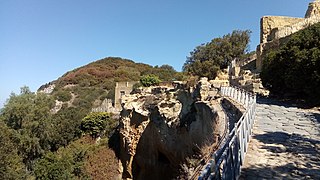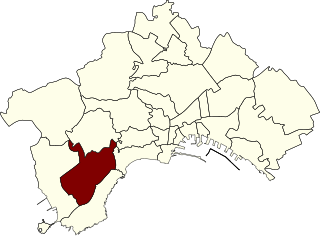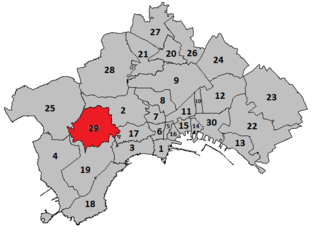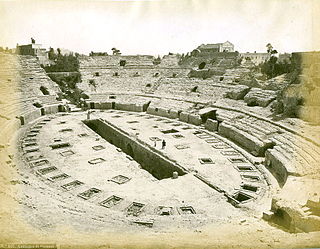
Cumae was the first ancient Greek colony of Magna Graecia on the mainland of Italy, founded by settlers from Euboea in the 8th century BC and soon became one of the strongest colonies. It later became a rich Roman city, the remains of which lie near the modern village of Cuma, a frazione of the comune Bacoli and Pozzuoli in the Metropolitan City of Naples, Campania, Italy.

Pozzuoli is a city and comune of the Metropolitan City of Naples, in the Italian region of Campania. It is the main city of the Phlegrean Peninsula.

The Grotta di Cocceio is an ancient Roman tunnel nearly a kilometre in length connecting Lake Avernus with Cumae and dating from 38-36 BC. It was burrowed through the tuff stone of Monte Grillo by the architect Lucius Cocceius Auctus at the command of Agrippa who was in the process of converting the Lake into a military port, the Portus Julius.

Lucius Cocceius Auctus was a Roman architect employed by Octavian's strategist Agrippa to excavate the subterranean passageways known as the crypta neapolitana connecting modern-day Naples and Pozzuoli and the Grotta di Cocceio, connecting Lake Avernus and Cumae. Cocceius was responsible for the conversion of the Capitolium in Pozzuoli into a Temple of Augustus with the backing of the merchant Lucius Calpurnius. Cocceius Auctus also built the original Pantheon in Rome.

Lake Avernus is a volcanic crater lake located in the Avernus crater in the Campania region of southern Italy, around 4 kilometres west of Pozzuoli. It is near the volcanic field known as the Phlegraean Fields and comprises part of the wider Campanian volcanic arc. The lake is roughly circular, measuring two kilometres in circumference and 60 metres deep.

Virgil's tomb is a Roman burial vault in Naples, said to be the tomb of the poet Virgil. It is located at the entrance to the old Roman tunnel known as the Crypta Neapolitana or grotta vecchia in the Piedigrotta district of the city, between Mergellina and Fuorigrotta.

The history of Naples is long and varied, dating to Greek settlements established in the Naples area in the 2nd millennium BC. During the end of the Greek Dark Ages a larger mainland colony – initially known as Parthenope – developed on the Pizzofalcone hill in the 8th century BC, and was refounded as Neapolis in the 6th century BC: it held an important role in Magna Graecia. The Greek culture of Naples was important to later Roman society. When the city became part of the Roman Republic in the central province of the Empire, it was a major cultural centre.

The Aqua Augusta, or Serino Aqueduct was one of the largest, most complex and costliest aqueduct systems in the Roman world; it supplied water to at least eight ancient cities in the Bay of Naples including Pompeii and Herculaneum. This aqueduct was unlike any other of its time, being a regional network rather than being focused on one urban centre.

Via Domiziana is the modern name for the Via Domitiana in the Campania region of Italy, a major Roman road built in 95 AD under the emperor, Domitian,https://it.wikipedia.org/wiki/Domiziano to facilitate access to and from the important ports of Puteoli and Portus Julius in the Gulf of Naples.

Posillipo is an affluent residential quarter of Naples, southern Italy, located along the northern coast of the Gulf of Naples.

Parco Vergiliano is a public park in Naples, southern Italy. It is located directly across from the Mergellina railway station and in back of the church of Santa Maria di Piedigrotta.

The Piscina Mirabilis is an Ancient Roman cistern on the Bacoli hill at the western end of the Gulf of Naples, southern Italy. It ranks as one of the largest ancient cisterns built by the ancient Romans, compared to the largest Roman reservoir, the Yerebatan Sarayi in Istanbul.

Fuorigrotta is a western suburb of Naples, southern Italy. Covering an area of 6,2 km2, it is the most populated suburb of the city.

Soccavo is a western quarter of Naples, with a population of about 45,000.
Miseno is one of the frazioni of the municipality of Bacoli in the Italian Province of Naples. Known in ancient Roman times as Misenum, it is the site of a great Roman port.

The Flavian Amphitheater, located in Pozzuoli, is the third-largest Roman amphitheater in Italy. Only the Roman Colosseum and the Amphitheatre of Capua are larger. It was likely built by the same architects who previously constructed the Roman Colosseum. The name "Flavian Amphitheater" is primarily associated with the Roman Colosseum.

The Cumaean Sibyl was the priestess presiding over the Apollonian oracle at Cumae, a Greek colony near Naples, Italy. The word sibyl comes from the ancient Greek word sibylla, meaning prophetess. There were many sibyls throughout the ancient world. Because of the importance of the Cumaean Sibyl in the legends of early Rome as codified in Virgil's Aeneid VI, and because of her proximity to Rome, the Cumaean Sibyl became the most famous among the Romans. The Erythraean Sibyl from modern-day Turkey was famed among Greeks, as was the oldest Hellenic oracle, the Sibyl of Dodona, dating to the second millennium BC according to Herodotus, favored in the east.
Naples (Italy) and its immediate surroundings preserve an archaeological heritage of inestimable value and among the best in the world. For example, the archaeological park of the Phlegraean Fields is directly connected to the centre of Naples through the Cumana railway, and the nearby sites of Pompeii, Herculaneum, Stabiae and Oplontis are among the World Heritage Sites of UNESCO.






















